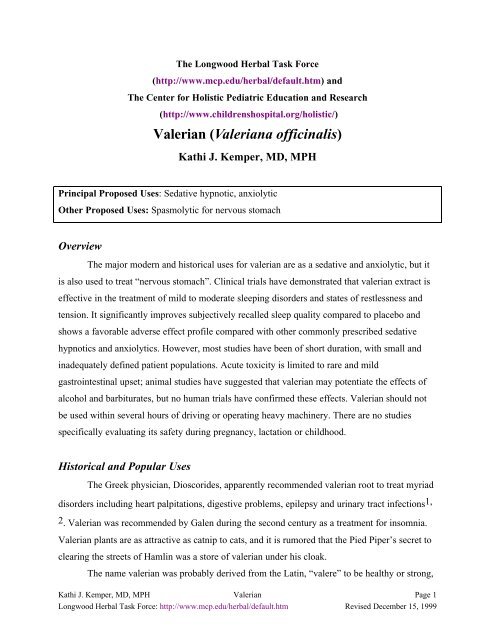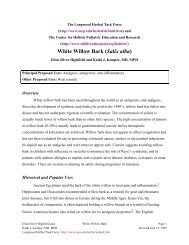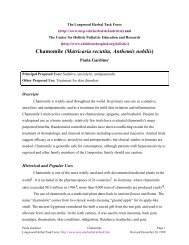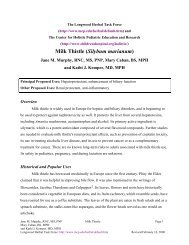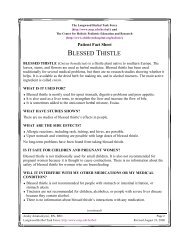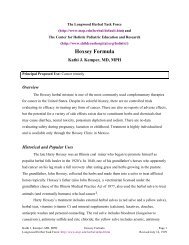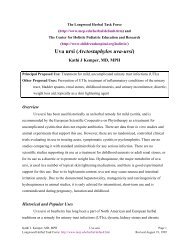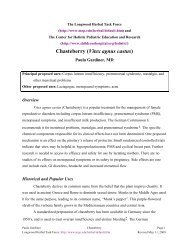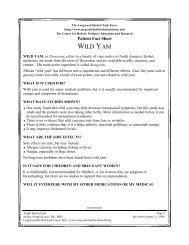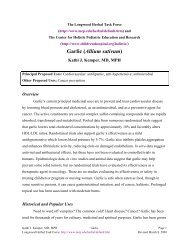Valerian (Valeriana officinalis) - Longwood Herbal Task Force
Valerian (Valeriana officinalis) - Longwood Herbal Task Force
Valerian (Valeriana officinalis) - Longwood Herbal Task Force
Create successful ePaper yourself
Turn your PDF publications into a flip-book with our unique Google optimized e-Paper software.
The <strong>Longwood</strong> <strong>Herbal</strong> <strong>Task</strong> <strong>Force</strong><br />
(http://www.mcp.edu/herbal/default.htm) and<br />
The Center for Holistic Pediatric Education and Research<br />
(http://www.childrenshospital.org/holistic/)<br />
<strong>Valerian</strong> (<strong>Valerian</strong>a <strong>officinalis</strong>)<br />
Kathi J. Kemper, MD, MPH<br />
Principal Proposed Uses: Sedative hypnotic, anxiolytic<br />
Other Proposed Uses: Spasmolytic for nervous stomach<br />
Overview<br />
The major modern and historical uses for valerian are as a sedative and anxiolytic, but it<br />
is also used to treat “nervous stomach”. Clinical trials have demonstrated that valerian extract is<br />
effective in the treatment of mild to moderate sleeping disorders and states of restlessness and<br />
tension. It significantly improves subjectively recalled sleep quality compared to placebo and<br />
shows a favorable adverse effect profile compared with other commonly prescribed sedative<br />
hypnotics and anxiolytics. However, most studies have been of short duration, with small and<br />
inadequately defined patient populations. Acute toxicity is limited to rare and mild<br />
gastrointestinal upset; animal studies have suggested that valerian may potentiate the effects of<br />
alcohol and barbiturates, but no human trials have confirmed these effects. <strong>Valerian</strong> should not<br />
be used within several hours of driving or operating heavy machinery. There are no studies<br />
specifically evaluating its safety during pregnancy, lactation or childhood.<br />
Historical and Popular Uses<br />
The Greek physician, Dioscorides, apparently recommended valerian root to treat myriad<br />
disorders including heart palpitations, digestive problems, epilepsy and urinary tract infections 1,<br />
2 . <strong>Valerian</strong> was recommended by Galen during the second century as a treatment for insomnia.<br />
<strong>Valerian</strong> plants are as attractive as catnip to cats, and it is rumored that the Pied Piper’s secret to<br />
clearing the streets of Hamlin was a store of valerian under his cloak.<br />
The name valerian was probably derived from the Latin, “valere” to be healthy or strong,<br />
Kathi J. Kemper, MD, MPH <strong>Valerian</strong> Page 1<br />
<strong>Longwood</strong> <strong>Herbal</strong> <strong>Task</strong> <strong>Force</strong>: http://www.mcp.edu/herbal/default.htm Revised December 15, 1999
eferring either to its aroma or its clinical effects 3 . Other accounts ascribe its name to the Roman<br />
emperor, Publius Licinius <strong>Valerian</strong>us, who reigned in the 3 rd century. Two other ancient names<br />
are “nard” and “phu”. “Nard” is derived from a Sanskrit word meaning “strong smell” and “phu”<br />
or “fu” refers to the usual exclamation of disgust that attends the experience of smelling the dried<br />
root.<br />
By the 18 th century, valerian was widely used as a sedative and to treat nervous disorders<br />
associated with a “restless” digestive tract as well as the “vapors” in women. Other common uses<br />
included the treatment of headaches, anxiety, palpitations, high blood pressure, irritable or<br />
spastic bowel, menstrual cramps, epilepsy and childhood behavior problems and learning<br />
disabilities 4, 5 . During World War I, valerian was used to prevent and treat shell shock in front-<br />
line troops, and it was used during World War II to help calm civilians subjected to air raids 6 .<br />
<strong>Valerian</strong> was listed as a sleep aid and anxiolytic on the US national formulary until the 1940’s 7 .<br />
It fell into disuse as more potent sedative-hypnotic pharmacologic agents became available.<br />
Related species have been used in Traditional Chinese Medicine (TCM), Ayurvedic<br />
Medicine and African herbal healing practices. V. fauriei is used in Traditional Chinese<br />
Medicine and Japanese medicine as a sedative, spasmolytic and antidepressant 8-14 . V. capensis<br />
is used in African traditional medicine as a treatment for epilepsy, hysteria and nervous<br />
disorders 15 .<br />
In the 1980’s valerian again assumed a place of importance as a widely used non-<br />
prescription hypnotic and daytime sedative, particularly in France, Belgium, Switzerland,<br />
Britain, Russia and Germany 6, 16-19 . Over 50 tons of valerian are sold each year in France<br />
alone. Adolescents and young adults appear to be particularly attracted to valerian and other<br />
herbs that affect the central nervous system 20 . The German Commission E has given <strong>Valerian</strong><br />
root a positive evaluation for use in states of restlessness 21, 22 . The European Scientific<br />
Cooperative on Phytotherapy cites its indications as “tenseness, restlessness and irritability with<br />
difficulty in falling asleep” 23 . The <strong>Herbal</strong> PDR lists its primary indications as “nervousness and<br />
insomnia”, as well as lack of concentration, stress headache, menstrual states of agitation,<br />
neuralgia, nervous stomach, and states of angst 24 . It has also been included in herbal remedies<br />
for cardiovascular disorders to help reduce hypertension and reduce the effects of stress and<br />
Kathi J. Kemper, MD, MPH <strong>Valerian</strong> Page 2<br />
<strong>Longwood</strong> <strong>Herbal</strong> <strong>Task</strong> <strong>Force</strong>: http://www.mcp.edu/herbal/default.htm Revised December 15, 1999
tension on the heart 6, 25, 26 . Some spas put valerian in whirlpool baths to help reduce pain and<br />
enhance sleep for patients with fibromyalgia 27 .<br />
<strong>Valerian</strong> is often used in combination with other sedative herbs such as chamomile,<br />
lemon balm, passion flower, St. John’s wort, hawthorn berries and hops 28-31 . Some consumers<br />
combine it with melatonin. In 1998, valerian was the 10 th most popular herbal remedy sold in the<br />
United States 32 .<br />
Botany<br />
Medicinal species: <strong>Valerian</strong>a <strong>officinalis</strong> is the species used in Europe. The genus contains over<br />
250 species, with many more subspecies. V. fauriei is used in Traditional Chinese<br />
Medicine and Japanese medicine 8-14 . V. capensis is used in African traditional<br />
medicine 15 . V. edulis is used in Mexico and V. wallichii is used in India. V. edulis<br />
contains substantially higher concentrations of valepotriates (up to 8%), which have<br />
mutagenic properties in vitro 33 .<br />
Common names: All-heal, amantilla, baldrian, Belgian valerian, capon’s tail, cat’s love, common<br />
valerian, English valerian, fragrant valerian, garden heliotrope, German valerian, great<br />
wild valerian, heliotrope, Indian valerian, setewale, setwall, valerian, valeriana, valeriana<br />
radix, vandal root, Vermont valerian, wild valerian, Baldrianwurzel (Ger),<br />
Balderbrackenwurzel (Ger), Katzenwurzel (Ger), racine de valeriane (Fr) 7, 24, 34<br />
Botanical family: <strong>Valerian</strong>aceae<br />
Plant description: The part of the plant used medicinally is the root or rhizome. The rhizome is<br />
light grayish brown, about the size of a finger joint, bearing many rootlets. The fresh root<br />
has no odor, while the dried root smells distinctly unpleasant, akin to old gym socks, due<br />
to isovaleric acid. The plant itself is 50 to 150 cm tall with pinnate leaves and white or<br />
pink hermaphroditic flowers with three stamens; the stem is upright and without<br />
branches 24, 35 . It is sometimes used as a border in perennial gardens.<br />
Where it’s grown: <strong>Valerian</strong> is native to Europe and Asia and has naturalized in eastern North<br />
America. This tall perennial prefers moist woodlands; it has been extensively cultivated<br />
in northern Europe. Most of the European supply is grown in Holland. It is cultivated in<br />
low lying, damp sandy humus with lime fertilizer. It is harvested in the late fall and dried.<br />
Kathi J. Kemper, MD, MPH <strong>Valerian</strong> Page 3<br />
<strong>Longwood</strong> <strong>Herbal</strong> <strong>Task</strong> <strong>Force</strong>: http://www.mcp.edu/herbal/default.htm Revised December 15, 1999
Biochemistry<br />
<strong>Valerian</strong>: Potentially Active Chemical Constituents<br />
• Iridoid valepotriates (0.5% -2.0%) 36 : valtrates, isovaltrate, didrovaltrate, valerosidate and<br />
others<br />
• Volatile essential oil (0.2 – 02.8%) 37 : bornyl isovalerenate and bornyl acetate; valerenic,<br />
valeric, isovaleric and acetoxyvalerenic acids; valerenal, valeranone, cryptofaurinol; and<br />
other monoterpenes and sesquiterpenes<br />
• Alkaloids (0.01 – 0.05%): valeranine, chatinine, alpha-methyl pyrrylketone, actinidine,<br />
skyanthine and naphthyridylmethylketone 38-41<br />
• Lignans: hydroxypinoresinol<br />
<strong>Valerian</strong> contains over 150 chemical constituents; many are physiologically active. There<br />
is substantial variation in the chemical constituents in plants from different sources, growing<br />
conditions, processing methods and storage conditions 16, 42-49 . Even in standardized plant<br />
extracts sold in Germany, there is some variation in the amount of different chemical<br />
constituents that may account for clinical efficacy 50 . Despite these differences, the clinical<br />
effects appear to be remarkably consistent across different preparations 51 .<br />
Although the sedative effects of the plant's root have been known for centuries, the exact<br />
chemical compounds responsible for its activities have not been identified and agreed upon.<br />
There is little correlation between the content of volatile oils and the plant’s clinical effects 37 .<br />
<strong>Valerian</strong>’s effects on the central nervous system have been variously attributed to valepotriates,<br />
their breakdown products (baldrinals), valerenic acid, valerenal and valeranone, and other<br />
constituents in the essential oil 16, 52-54 .<br />
Isovaleric acid is responsible for the herb’s unpleasant aroma. Actinidine is a powerful<br />
attractant to cats, who will roll in valerian; catnip contains similar chemical compounds 55 .<br />
<strong>Valerian</strong> also seems to be one of several plant species that concentrate chromium and are<br />
sometimes used to correct deficiencies of this mineral in developing countries 56 .<br />
The essential oil is also thought to contribute to valerian’s sedative effects 35, 57-59 .<br />
Kathi J. Kemper, MD, MPH <strong>Valerian</strong> Page 4<br />
<strong>Longwood</strong> <strong>Herbal</strong> <strong>Task</strong> <strong>Force</strong>: http://www.mcp.edu/herbal/default.htm Revised December 15, 1999
Valerenic acid has spasmolytic and muscle relaxant effects and inhibits the breakdown of<br />
gamma aminobutyric acid (GABA) in the central nervous system (CNS) 35, 52 . Valeric acid was<br />
once considered to be responsible for the sedative effects of this herb, but studies evaluating the<br />
isolated compound failed to document any sedative effects 33 .<br />
Roots dried at temperatures less than 40 degrees Centigrade, as the German<br />
pharmacopeia requires, contain 0.5% - 2.0% valepotriates 60-62 . Although valepotriates were<br />
once thought to be the active ingredients, these compounds are chemically unstable: they degrade<br />
readily, are poorly absorbed and are not found in teas (infusions) and tinctures 58, 63-66 . Instead,<br />
their degradation products, baldrinals, are found in such preparations, and may account for much<br />
of valerian’s sedative effect 59, 61, 67, 68 .<br />
The lignan hydroxypinoresinol also binds benzodiazepine receptors in the amygdala and<br />
is thought to work synergistically with bornyl acetate, valerenic acid, and the valepotriates in<br />
terms of valerian’s overall sedative effects 69 .<br />
<strong>Valerian</strong>’s alkaloids are present only in minute amounts 41 . They have cholinesterase<br />
activity in vitro which has not been verified in animals or humans 37 .<br />
Because no single chemical within valerian has been shown to account for its clinical<br />
effects, most herbalists now conclude that it is a combination of ingredients, rather than a single<br />
ingredient, that accounts for valerian’s medicinal effects 70 .<br />
Remedies prepared from related species, V. edulis (Mexican valerian) or V. wallichii<br />
(Indian valerian) contain mixtures of valepotriates, with large amounts of didrovaltrate and<br />
isovaltrate; these preparations are used to treat problems with mental concentration, stress and<br />
anxiety 35 .<br />
The onset of action appears to be within 30 minutes; the effects are largely gone within<br />
four hours. However, other studies note cumulative benefits from taking the herb several times<br />
daily over one month. Additional pharmacokinetic studies are needed.<br />
Kathi J. Kemper, MD, MPH <strong>Valerian</strong> Page 5<br />
<strong>Longwood</strong> <strong>Herbal</strong> <strong>Task</strong> <strong>Force</strong>: http://www.mcp.edu/herbal/default.htm Revised December 15, 1999
Experimental Studies<br />
<strong>Valerian</strong>: Potential Clinical Benefits<br />
1. Cardiovascular: Coronary dilating and antiarrthymic effects<br />
2. Pulmonary: none<br />
3. Renal and electrolyte balance: none<br />
4. Gastrointestinal/hepatic: Spasmolytic<br />
5. Neuropsychiatric: Sedative hypnotic, anxiolytic, attention-enhancing (treatment of ADHD),<br />
other neurologic conditions<br />
6. Endocrine: none<br />
7. Hematologic: none<br />
8. Rheumatologic: none<br />
9. Reproductive: none<br />
10. Immune modulation: none<br />
11. Antimicrobial: none<br />
12. Antineoplastic: none<br />
13. Antioxidant: none<br />
14. Skin and mucus membranes: none<br />
15. Other/miscellaneous: none<br />
1. Cardiovascular: Coronary dilating and antiarrthymic effects<br />
i. In vitro data: none<br />
ii. Animal data: <strong>Valerian</strong> extract has coronary dilatating and antiarrhythmic effects in<br />
rabbits, mice and cats; valepotriates prevented the appearance of acute coronary<br />
insufficiency, abolished vasopressin-induced arrhythmia, provoked a short-lived increase<br />
of coronary blood flow, and had moderate positive inotropic and negative chronotropic<br />
effects 71 . In mice, valeranone, found in small quantities in valerian and in larger amounts<br />
in its relative, Nardostachys jatamansii, exerted weak hypotensive effects 37 . In cats,<br />
intravenous injection of valerian extracts produced a significant increase in coronary<br />
blood flow, a transient fall in blood pressure and a decrease in heart rate 72 .<br />
iii. Human data: <strong>Valerian</strong> is included in a German heart tonic to maintain neuro-cardiac<br />
Kathi J. Kemper, MD, MPH <strong>Valerian</strong> Page 6<br />
<strong>Longwood</strong> <strong>Herbal</strong> <strong>Task</strong> <strong>Force</strong>: http://www.mcp.edu/herbal/default.htm Revised December 15, 1999
stability 6 . In an open, multicenter trial of 2,243 patients with a variety of functional<br />
cardiac disorders, an herbal combination (valerian, hawthorn, cereus and camphor) was<br />
associated with improvement in 84% of patients 73 .<br />
No controlled trials have evaluated its effects in patients with specific<br />
cardiovascular disorders.<br />
2. Pulmonary: none<br />
3. Renal and electrolyte balance: none<br />
4. Gastrointestinal/hepatic: Spasmolytic. <strong>Valerian</strong> is traditionally used in the treatment of<br />
intestinal spasms, colic, and “nervous stomach”. <strong>Valerian</strong> has a bitter flavor, and bitters have<br />
historically been used to enhance appetite and digestion.<br />
i. In vitro data: Valerenic acid, valtrate and valeranone exert spasmolytic effects in guinea<br />
pig ileum through direct effects on smooth muscle 74, 75 .<br />
ii. Animal data: none<br />
iii. Human data: none<br />
5. Neuro-psychiatric: Sedative-hypnotic, anxiolytic, attention-enhancing (treatment of<br />
ADHD), other neurologic conditions<br />
a. Sedative-hypnotic. Numerous studies have shown that valerian extract possesses mild<br />
sedative and tranquilizing characteristics, but the mechanism of action for this effect has<br />
not been clarified. Some constituents influence gamma-aminobutyric acid (GABA)<br />
metabolism and cortical membrane receptors.<br />
i. In vitro data: <strong>Valerian</strong> extracts containing amino acids and valerenic acid bind<br />
weakly with the GABA(A) receptor in rat brain assay 76-78 . In rat brain cortex,<br />
aqueous extract of valerian inhibited the uptake and stimulated the release of GABA,<br />
leading to increased concentrations of GABA in synaptic clefts 79 ; these effects may<br />
be due in part to the presence of GABA in valerian root extracts 80, 81 , and/or to<br />
valerenic acid’s ability to inhibit GABA breakdown 82 .<br />
ii. Animal data: In mice, intraperitoneal injections of valerenic acid, valerenal and whole<br />
herb extracts produced significant sedation, ataxia and anticonvulsant effects 52, 67 .<br />
Intraperitoneal injections of 100 mg/kg had sedative effects as strong as barbiturates;<br />
doses of 400 mg/kg led to death 53 . In comparison with diazepam and<br />
Kathi J. Kemper, MD, MPH <strong>Valerian</strong> Page 7<br />
<strong>Longwood</strong> <strong>Herbal</strong> <strong>Task</strong> <strong>Force</strong>: http://www.mcp.edu/herbal/default.htm Revised December 15, 1999
chlorpromazine, valerian extract had weak anticonvulsive properties 83 . <strong>Valerian</strong> root<br />
extract (Valdispert ® ) reduced motility and increased thiopental-induced and<br />
pentobarbital-induced sleeping time 83-85 . Even the aroma of valerian root exerted<br />
sedative effects in mice 86 .<br />
In rats, valerian had sedative effects on EEG activity 87 . <strong>Valerian</strong> extract, but<br />
not its individual chemical constituents, significantly decreased glucose metabolism<br />
in the brain 88 . Valepotriates suppressed symptoms associated with diazepam<br />
withdrawal 89 . This has led some authors and clinicians to propose that valerian may<br />
be useful in treating benzodiazepine withdrawal syndrome 90 .<br />
Cats given 10 mg/kg of a valerian extract by gastric lavage had a significant<br />
decrease in restless, fearful and aggressive behaviors 91 .<br />
iii. Human data: Case series and randomized controlled trials have demonstrated that<br />
valerian extract is effective in the treatment of mild-to-moderate sleeping disorders<br />
without adverse effects on REM sleep or significant hangover effects.<br />
In an open label case series of 11,168 patients, over 70% reported that<br />
valerian was effective in helping them fall asleep, reducing sleep disturbances and<br />
decreasing restlessness and tension 92 . In adults whose sleep was disturbed by heavy<br />
traffic noise, Seda-Kneipp ® (a combination of valerian and hops) reduced noise-<br />
induced sleep disturbances, increasing both slow-wave sleep and REM sleep 93 . In an<br />
open label trial of another valerian-containing herbal remedy, Novo-Baldriparan ® ,<br />
89% of 225 patients with sleep difficulties reported improvements in their ability to<br />
fall asleep and 80% reported improvements in their ability to sleep through the night;<br />
most also reported an improvement in overall well-being 94 .<br />
Randomized trials have consistently demonstrated that valerian is significantly<br />
more effective than placebo in improving sleep in persons with disturbed sleep 95-<br />
103 .<br />
For example, in three randomized, placebo-controlled trials (N=128, N=8 and<br />
N=121) of adults with insomnia or other sleep problems, those given aqueous<br />
valerian extract (400-600 mg) one hour before bed had a statistically significant<br />
Kathi J. Kemper, MD, MPH <strong>Valerian</strong> Page 8<br />
<strong>Longwood</strong> <strong>Herbal</strong> <strong>Task</strong> <strong>Force</strong>: http://www.mcp.edu/herbal/default.htm Revised December 15, 1999
decrease in sleep latency and a significant improvement in sleep quality and daytime<br />
mood. The improvement was most notable among people who were poor or irregular<br />
sleepers, smokers, and people who thought they normally had long sleep latencies.<br />
<strong>Valerian</strong> had no detectable "hangover" effect the next morning 33, 97, 99 .<br />
In two randomized, placebo-controlled, double-blind studies of healthy young<br />
people without sleep difficulties, aqueous valerian extract (450 or 900 milligrams<br />
taken 30 minutes before bed) had a significant sleep-promoting action without a<br />
significant residual or "hangover" effect 101 .<br />
<strong>Valerian</strong> affects EEG measures of sleep in both poor and normal sleepers. The<br />
effect of a valerian extract (Valdispert Forte, 405 mg t.i.d.) on EEG recordings of<br />
sleep was studied in 14 elderly poor sleepers. Subjects in the valerian group had an<br />
increase in slow-wave sleep (SWS) and a decrease in stage 1 sleep. There was no<br />
effect on self-reported sleep quality, sleep onset time, REM sleep time or time awake<br />
after sleep onset 102 . In a randomized double-blind study the effects of 60 and 120 mg<br />
valerian (Harmonicum Much ® ) were investigated in 11 adults by computer analysis<br />
of sleep stages and questionnaires. Both dosages showed a decrease of sleep stage 4<br />
and a slight reduction of REM-sleep, and a slight increase of sleep stages 1, 2 and 3.<br />
Changes in the beta-intensity of the EEG during REM-sleep showed a stronger<br />
hypnotic effect for the 120 mg dosage than for 60 mg. Maximum effect was observed<br />
between 2 and 3 hours post medication 104 .<br />
Two randomized trials have compared the effectiveness of valerian-containing<br />
herbal combinations to placebo in treating insomnia. In one randomized, placebo-<br />
controlled, double-blind cross-over study of 27 patients with sleep difficulties, 400<br />
mg of a valerian-containing preparation (Valerina Natt ® ) was compared with a similar<br />
herbal remedy that did not contain valerian, but did contain lemon balm and hops. Of<br />
the 27 patients, 21 rated the valerian-containing mixture as significantly more<br />
effective than the control preparation in terms of sleep quality; 24 of the 27 patients<br />
(89%) reported "improved sleep" and 12 of these patients (44%) reported "perfect<br />
sleep" after taking the valerian-containing preparation. No adverse effects were<br />
observed 105 . In a placebo-controlled trial of 15 patients with insomnia, there was a<br />
Kathi J. Kemper, MD, MPH <strong>Valerian</strong> Page 9<br />
<strong>Longwood</strong> <strong>Herbal</strong> <strong>Task</strong> <strong>Force</strong>: http://www.mcp.edu/herbal/default.htm Revised December 15, 1999
. Anxiolytic<br />
significant decrease in slow wave sleep and an increase in stage II sleep among those<br />
assigned to the herbal combination remedy (500 mg valerian and 120 mg hops) 106 .<br />
At least four randomized, controlled trials have compared valerian-containing<br />
herbal remedies to benzodiazepines in the treatment of insomnia. A valerian-lemon<br />
balm herbal preparation was compared to Halcion (0.125 mg), and placebo in a<br />
double-blind trial of 20 adults suffering from insomnia. The two active treatments<br />
were equivalent and both were significantly better than placebo; the herbs caused less<br />
daytime sedation and impaired mental functioning than the Halcion 107 . These results<br />
were confirmed in a subsequent study of 68 patients 108 . Similarly, in another<br />
randomized trial, an herbal combination (hops and valerian) was equally effective as<br />
benzodiazepine medications in improving sleep, but had fewer side effects 29 . Finally,<br />
in a controlled study of 80 healthy volunteers, two herbal combinations (containing<br />
valerian and hops) were compared to flunitrazepam and placebo to assess potential<br />
hazards in driving or operating machinery. Objectively measurable impairment of<br />
performance on the morning after medication occurred only in the flunitrazepam<br />
group. In addition, 50% of the volunteers in the flunitrazepam group reported mild<br />
side effects, compared with only 10% from the other groups. Examination of acute<br />
effects of the plant remedies 1 to 2 hours after administration revealed a very slight,<br />
but statistically significant impairment of vigilance and a retardation in the processing<br />
of complex information 109 .<br />
i. In vitro data: See above data for sedative effects.<br />
ii. Animal data: See above data for sedative effects.<br />
iii. Human data: Both open label studies and randomized controlled trials support<br />
valerian’s use as a mild anxiolytic.<br />
In an open label case series, 70 hospitalized patients with diverse<br />
psychosomatic diagnoses were given 150 – 300 mg daily doses of Valmane ® .<br />
Functional cardiac disorders, tachycardia, hypertension, sweating, restless legs and<br />
other dysregulations were influenced positively by Valmane. The preparation<br />
produced mild sedative effects and was effective in the treatment of restlessness and<br />
Kathi J. Kemper, MD, MPH <strong>Valerian</strong> Page 10<br />
<strong>Longwood</strong> <strong>Herbal</strong> <strong>Task</strong> <strong>Force</strong>: http://www.mcp.edu/herbal/default.htm Revised December 15, 1999
tension. Apart from mild daytime fatigue, there were no adverse somatic or<br />
psychotropic effects 110 .<br />
In a double-blind trial of 48 adults placed in an experimental situation of<br />
social stress, valerian supplements reduced subjective sensations of anxiety but did<br />
not cause any measurable sedation 111 . In a randomized, double-blind study of 80<br />
adult patients with various anxiety syndromes, standardized valerian extract<br />
(Valdispert ® 270 mg daily) was as effective and well tolerated as clobazam 30 mg<br />
daily, according to the Hamilton Anxiety Rating Scale and the Leeds anxiety<br />
questionnaire 112 .<br />
<strong>Herbal</strong> combinations containing valerian have also been more effective than<br />
placebo in randomized trials. In a German study, Euphytose ® (six herbs including<br />
valerian) was compared with placebo over 28 days of treatment in 182 patients<br />
diagnosed with adjustment disorder and anxious mood; there was a statistically<br />
significant improvement in Hamilton anxiety scores in the 91 patients treated with the<br />
herbal mixture, compared to their own baseline scores and to the outcome scores in<br />
the placebo treated group 113 .<br />
<strong>Valerian</strong>-containing herbal remedies have also compared favorably with<br />
medications in the treatment of anxiety-related disorders. In a double-blind controlled<br />
trial of 100 adults suffering from anxiety disorders, patients were assigned to twice-<br />
daily treatment with an herbal combination (50 mg of valerian and 100 mg of St.<br />
John’s wort) or diazepam (2 mg) for two weeks; the herbal combination was<br />
reportedly effective in 78%, while diazepam was effective for only 54% of patients<br />
(P
c. Attention-enhancing (treatment of ADHD)<br />
i. In vitro data: none<br />
ii. Animal data: none<br />
iii. Human data: In Germany valerian is sometimes used to treat attention deficit<br />
hyperactivity disorder (ADHD) in children 116 . German studies from the 1960’s<br />
reported that valerian could antagonize the hypnotic effects of alcohol, enhancing<br />
concentration and coordination 6 .<br />
In a randomized, placebo-controlled, double-blind study, valepotriates<br />
(Valmane ® ) demonstrated a dose-dependent increase in concentration abilities in 24<br />
healthy volunteers; when given in combination with alcohol, they did not affect blood<br />
alcohol levels, sedative effects or effects on driving performance 117 .<br />
There are no controlled trials evaluating valerian’s use in treating attention<br />
deficit hyperactivity disorder (ADHD) 6 .<br />
d. Other neurologic conditions. Some European herbalists and physicians use valerian-<br />
containing preparations to treat a variety of central, peripheral and autonomic nervous<br />
system problems and psychosomatic conditions 110 .<br />
i. In vitro data: See above studies on sedative effects.<br />
ii. Animal data: Unlike diazepam, valerian did not affect spontaneous ambulation and<br />
rearing or approach-avoidance conflict in mice in a water-lick conflict test. On the<br />
other hand, valerian and imipramine significantly inhibited immobility induced by a<br />
forced swimming test in rats and significantly reversed reserpine-induced<br />
hypothermia in mice, leading researchers to conclude that valerian may be a useful<br />
antidepressant 10 .<br />
iii. Human data: Among 80 hospitalized geriatric patients enrolled in a placebo-<br />
controlled trial for 14 days, those assigned to an aqueous valerian extract had<br />
significant improvements in mood and behavioral disturbances as well as sleep 100 .<br />
Among 121 patients with sleep disturbances enrolled in a controlled trial,<br />
those assigned to an alcoholic extract of valerian (600 mg daily for 28 days) had a<br />
significant improvement in depression, mood and global functioning as well as sleep;<br />
no significant side effects were reported 103 .<br />
Kathi J. Kemper, MD, MPH <strong>Valerian</strong> Page 12<br />
<strong>Longwood</strong> <strong>Herbal</strong> <strong>Task</strong> <strong>Force</strong>: http://www.mcp.edu/herbal/default.htm Revised December 15, 1999
6. Endocrine: none<br />
7. Hematologic: none<br />
8. Rheumatologic: none<br />
9. Reproductive: none<br />
10. Immune modulation: none<br />
11. Antimicrobial: none<br />
12. Antineoplastic: none<br />
13. Antioxidant: none<br />
14. Skin and mucus membranes: none<br />
15. Other/miscellaneous: none<br />
Kathi J. Kemper, MD, MPH <strong>Valerian</strong> Page 13<br />
<strong>Longwood</strong> <strong>Herbal</strong> <strong>Task</strong> <strong>Force</strong>: http://www.mcp.edu/herbal/default.htm Revised December 15, 1999
Toxicity and Contraindications<br />
All herbal products carry the potential for contamination with other herbal products, pesticides,<br />
herbicides, heavy metals, and pharmaceuticals.<br />
Furthermore, allergic reactions can occur to any natural product in sensitive persons<br />
Allergic reactions and contact dermatitis to valerian have been reported, but are rare.<br />
Potentially toxic compounds in valerian: See Biochemistry section for a list of ingredients 118 .<br />
Toxicity testing in rats revealed that the essential oil of valerian had the lowest toxicity of<br />
any essential oil tested, including oil of peppermint and oil of anise 23, 119 .<br />
Acute toxicity: In a study of 23 patients taking a nonprescription valerian extract preparation<br />
(doses from 0.5 to 12 grams), no acute or subclinical evidence of liver damage was<br />
observed 120, 121 . <strong>Valerian</strong> extract may have caused nausea in 1 of 166 people taking<br />
400 milligrams one hour before bedtime 97 . In other studies, up to 10% of patients<br />
reported side effects such as headache and stomach upset 33 .<br />
<strong>Valerian</strong> is on the FDA’s Generally Recognized as Safe (GRAS) list and is<br />
approved for use as a food. Overdoses as high as 20 times the normal daily dose have not<br />
been associated with significant morbidity 122 . A young adult drug user attempted to get<br />
high by injecting an alcoholic solution of valerian; he became ill, but recovered over<br />
three days 123 .<br />
Unlike benzodiazepines, valerian appears to cause no residual morning sleepiness<br />
or impairments in driving abilities; however, it may impair judgment and driving ability<br />
for two to three hours after intake 109 . Drivers and operators of heavy machinery should<br />
be cautioned NOT to use valerian prior to using dangerous equipment.<br />
Chronic toxicity: The <strong>Herbal</strong> PDR suggests that long-term use may be associated with<br />
headaches, restless states, sleeplessness, mydriasis and vague cardiac disturbance 24, 37 ;<br />
however, there are no long-term data specifically evaluating these concerns, and given<br />
the usual indications for using valerian, it is difficult to determine a causal relationship.<br />
Chronic use of high doses (at least 5 grams daily) can lead to withdrawal symptoms if the<br />
herb is abruptly discontinued 2, 124 . Cautions about hepatic impairment have been based<br />
Kathi J. Kemper, MD, MPH <strong>Valerian</strong> Page 14<br />
<strong>Longwood</strong> <strong>Herbal</strong> <strong>Task</strong> <strong>Force</strong>: http://www.mcp.edu/herbal/default.htm Revised December 15, 1999
on a combination multi-herb and medication preparation that is unavailable in the US 120,<br />
125 . Cytotoxic effects have been reported in vitro, but the compounds responsible for<br />
these effects (valepotriates) rapidly decompose during storage and following oral<br />
administration 126, 127 .<br />
Limitations during other illnesses or in patients with specific organ dysfunction: Unknown<br />
Interactions with other herbs or pharmaceuticals: Unknown. A middle-aged woman who took<br />
St. John’s wort, valerian and loperamide suffered an adverse reaction and was<br />
hospitalized; the agent or interactions responsible for her symptoms (agitation, delirium,<br />
coma, unresponsiveness) were not determined 128 . Animal studies suggest that valerian<br />
may potentiate the sedative effects of barbiturates 10, 52, 83, 84 . Although many authors<br />
have speculated about potential interactions between valerian, alcohol, barbiturates and<br />
benzodiazepines in humans, no such interactions have been reported 129, 130 . One study<br />
found no potentiating effects of valerian on alcohol’s impact on concentration,<br />
attentiveness, reaction time or driving performance 131 .<br />
Safety during pregnancy, lactation and/or childhood: Unknown. No adverse effects have been<br />
reported when taken in typical doses, but safety during pregnancy and lactation has not<br />
been established. Some tinctures contain 40% - 60% alcohol. Mutagenic effects on<br />
bacteria were reported from the decomposition products of valtrate and isovaltrate, but<br />
these compounds are unstable in aqueous solution 132, 133 ; the implications for human<br />
use of this finding in bacteria are uncertain. In pregnant rats given valepotriates for 30<br />
days, there was no impact on fertility, fetotoxicity or other adverse effects on mother or<br />
offspring 134 . Long-term administration to pregnant rats and their offspring did not lead<br />
to any adverse effects 37 .<br />
Kathi J. Kemper, MD, MPH <strong>Valerian</strong> Page 15<br />
<strong>Longwood</strong> <strong>Herbal</strong> <strong>Task</strong> <strong>Force</strong>: http://www.mcp.edu/herbal/default.htm Revised December 15, 1999
Typical Dosages<br />
Provision of dosage information dose NOT constitute a recommendation or endorsement, but<br />
rather indicates the range of doses commonly used in herbal practice.<br />
Doses are given for single herb use and must be adjusted when using herbs in combinations.<br />
Doses may also vary according to the type and severity of the condition treated and individual<br />
patient conditions.<br />
Adult doses: There is disagreement on the optimal form and dose of valerian. The composition<br />
and concentration of commercially available valerian extract preparations vary widely,<br />
and caution must be exercised in determining appropriate dosage regimens. Reputable<br />
physicians and herbalists recommend a range of doses:<br />
Tea (infusion or decoction): 150 ml hot water poured over ½ - 1 tsp (2 - 5 gm) dried root,<br />
steeped for 10 - 15 minutes and strained. One cup two times daily and before<br />
bed 21, 35 . Tea bags contain, on average, 2 grams of dried root per bag. Total<br />
daily dose is up to 15 grams 24 .<br />
Concentrated infusion: 2 - 4 ml one to three times daily 135<br />
Tincture: ½ - 1 tsp (1 - 3 ml) one to three times daily16, 21<br />
Extracts: 0.3 – 1.0 ml, equivalent to 2 - 3 grams of drug, one to three times daily21, 135<br />
Plant juice: 1 tablespoonful three times daily 24<br />
Pills or capsules: For treatment of mild-to-moderate sleeping disorders, most studies have used<br />
400 to 900 mg of valerian extract orally one to two hours before bed 97, 101, 105 .<br />
Oral doses for restlessness and tension range from 100 to 1800 mg of<br />
valerian extract daily and can be administered once daily or in three divided<br />
doses; most often doses of 300 - 400 mg are suggested for use up to three times<br />
daily 1, 16, 110 .<br />
External use: 100 grams of dried herb mixed with 2 liters of hot water; this is steeped, strained<br />
and added to the bath 21, 24 .<br />
Pediatric dosages: The German Commission E recommends valerian extract 220 milligrams<br />
three times daily for treatment of restlessness and sleep disorders in children fourteen<br />
years of age and younger. However, only products that are free of valepotriates and<br />
Kathi J. Kemper, MD, MPH <strong>Valerian</strong> Page 16<br />
<strong>Longwood</strong> <strong>Herbal</strong> <strong>Task</strong> <strong>Force</strong>: http://www.mcp.edu/herbal/default.htm Revised December 15, 1999
aldrinals are approved for children as these substances have been implicated as<br />
mutagenic alkylating agents 21, 136 . Fortunately, these substances are very unstable and<br />
are not found in the vast majority of valerian products, and the small amounts in the<br />
remainder are rapidly metabolized following oral ingestion. The European Scientific<br />
Cooperative on Phytotherapy approves of valerian for children from 3 - 12 years of age<br />
under medical supervision 23 .<br />
Availability of standardized preparations: Different commercial preparations have commonly<br />
been standardized according to the content of valepotriates, as have crude drugs. Newer<br />
European standards set 0.5% essential oil as a minimum standard.<br />
Dosages used in herbal combinations: Variable. More than 80 commercial preparations<br />
containing valerian are available in the UK.<br />
Proprietary names: Baldrisedone ,Valmane, Baldrian Dispert, Baldrian Phyton coated tablets,<br />
Baldrianetten N, Sedalint Baldrian, Sedonium, Valdispert 136<br />
Multi-ingredient preparations containing valerian: Euvegal coated tablets, Hova Kinder<br />
suppositories, Hovaletten coated tablets, Luvased tablets, Moradorm tablets, Plantival<br />
drops, Valdipert tablets 136<br />
NOTE: The German Commission E and the <strong>Herbal</strong> PDR note that valerian should be stored<br />
away from light 21, 24 .<br />
Kathi J. Kemper, MD, MPH <strong>Valerian</strong> Page 17<br />
<strong>Longwood</strong> <strong>Herbal</strong> <strong>Task</strong> <strong>Force</strong>: http://www.mcp.edu/herbal/default.htm Revised December 15, 1999
REFERENCES<br />
1. Brown DJ. <strong>Herbal</strong> prescriptions for better health : your everyday guide to prevention, treatment, and care.<br />
Rocklin, CA: Prima Publishing, 1996.<br />
2. Flynn R, Roest M. Your guide to standardized herbal products. Prescott, AZ: One World Press, 1995.<br />
3. Hobbs C. <strong>Valerian</strong> monograph. <strong>Herbal</strong>Gram 1989; 21:19-34.<br />
4. Klich R. Behavior disorders in childhood and their therapy. Med Welt 1975; 26:1251-4.<br />
5. Hoffman D. The complete illustrated holistic herbal. Rockport, MA: Element Books Inc., 1996.<br />
6. Mowrey DB. The scientific validation of herbal medicine. New Canaan, Conn.: Keats Pub., 1986:xx, 316.<br />
7. Peirce A. The American Pharmaceutical Association practical guide to natural medicines. New York:<br />
William Morrow and Company, Inc., 1999.<br />
8. Huang KC. The pharmacology of Chinese herbs. Boca Raton: CRC Press, 1999.<br />
9. Nishiya K, Kimura T, Takeya K, Itokawa H. Sesquiterpenoids and iridoid glycosides from <strong>Valerian</strong>a<br />
fauriei. Phytochemistry 1992; 31:3511-4.<br />
10. Sakamoto T, Mitani Y, Nakajima K. Psychotropic effects of Japanese valerian root extract. Chem Pharm<br />
Bull (Tokyo) 1992; 40:758-61.<br />
11. Hikino H, Hikino Y, Kato H, Takeshita Y, Takemoto T. Constituents of wild Japanese valerian root. 1.<br />
Yakugaku Zasshi 1971; 91:766-9.<br />
12. Hikino H, Ono M, Takemoto T. Constituents of wild Japanese valerian root. 2. Yakugaku Zasshi 1972;<br />
92:479-81.<br />
13. Hikino H, Hikino Y, Nakamara R, Ono M, Takemoto T. Constituents of wild Japanese valerian root. 3.<br />
Yakugaku Zasshi 1972; 92:498-502.<br />
14. Hikino H, Kato T, Takemoto T. Constituents of wild Japanese valerian roots. (4). Yakugaku Zasshi 1975;<br />
95:243-5.<br />
15. Iwu MM. Handbook of African medicinal plants. Boca Raton: CRC Press, 1993.<br />
16. Bradley PR. British herbal compendium : a handbook of scientific information on widely used plant drugs /<br />
published by the British <strong>Herbal</strong> Medicine Association and produced by its Scientific Committee.<br />
Bournemouth, Dorset: The Association, 1992.<br />
17. Lewis WH. Medical botany : plants affecting man's health. New York: Wiley, 1977.<br />
18. Wagner J, Wagner ML, Hening WA. Beyond benzodiazepines: alternative pharmacologic agents for the<br />
treatment of insomnia. Ann Pharmacother 1998; 32:680-91.<br />
19. Cott J. NCDEU update. Natural product formulations available in europe for psychotropic indications.<br />
Psychopharmacol Bull 1995; 31:745-51.<br />
20. Heiligenstein E, Guenther G. Over-the-counter psychotropics: a review of melatonin, St John's wort,<br />
valerian, and kava-kava. J Am Coll Health 1998; 46:271-6.<br />
21. Blumenthal M. The complete German Commission E monographs : therapeutic guide to herbal medicines.<br />
Austin: American Botanical Council, 1998.<br />
22. Hoelzl J. <strong>Valerian</strong>: agent for sleep disturbances and nervousness. Deutsche Apotheker Zeitung 1996;<br />
Kathi J. Kemper, MD, MPH <strong>Valerian</strong> Page 18<br />
<strong>Longwood</strong> <strong>Herbal</strong> <strong>Task</strong> <strong>Force</strong>: http://www.mcp.edu/herbal/default.htm Revised December 15, 1999
136:17-20,23,25.<br />
23. Anonymous. Monographs on the medicinal uses of plants. Exeter: European Scientific Cooperative on<br />
Phytotherapy, 1997.<br />
24. Fleming T. PDR for herbal medicines. Montvale, NJ: Medical Economics Company, Inc., 1998.<br />
25. Straube G. The importance of valerian roots in therapy. Ther Ggw 1968; 107:555-62.<br />
26. Drozdov DD. Use of aminazine with valerian in hypertensive disease. Vrach Delo 1975:48-50.<br />
27. Ammer K, Melnizky P. Medicinal baths for treatment of generalized fibromyalgia. Forsch<br />
Komplementarmed 1999; 6:80-5.<br />
28. O'Hara M, Kiefer D, Farrell K, Kemper K. A review of 12 commonly used medicinal herbs. Arch Fam Med<br />
1998; 7:523-36.<br />
29. Schmitz M, Jackel M. Comparative study for assessing quality of life of patients with exogenous sleep<br />
disorders (temporary sleep onset and sleep interruption disorders) treated with a hops-valarian preparation<br />
and a benzodiazepine drug. Wien Med Wochenschr 1998; 148:291-8.<br />
30. Wong AH, Smith M, Boon HS. <strong>Herbal</strong> remedies in psychiatric practice. Arch Gen Psychiatry 1998;<br />
55:1033-44.<br />
31. Yager J, Siegfreid SL, DiMatteo TL. Use of alternative remedies by psychiatric patients: illustrative<br />
vignettes and a discussion of the issues. Am J Psychiatry 1999; 156:1432-8.<br />
32. Fugh-Berman A, Cott JM. Dietary supplements and natural products as psychotherapeutic agents.<br />
Psychosom Med 1999; 61:712-28.<br />
33. Schulz V, Hansel R, Tyler VE. Rational Phytotherapy: A Physicians' Guide to <strong>Herbal</strong> Medicine. Berlin:<br />
Springer, 1997:306.<br />
34. Brinker FJ. Herb contraindications and drug interactions : with appendices addressing specific conditions<br />
and medicines. Sandy, Or.: Eclectic Institute, 1997:146.<br />
35. Bissett NG. <strong>Herbal</strong> Drugs and Phytopharmaceuticals. Stuttgart: MedPharm CRC Press, 1994:566.<br />
36. Becker H, Chavadej S. Valepotriate production of normal and colchicine-treated cell suspension cultures of<br />
<strong>Valerian</strong>a wallichii. J Nat Prod 1985; 48:17-21.<br />
37. Morazzoni P, Bombardelli E. <strong>Valerian</strong>a <strong>officinalis</strong>: traditional use and recent evaluations of activity.<br />
Fitoterapia 1995; 66:99-112.<br />
38. Franck B, Petersen U, Huper F. <strong>Valerian</strong>ie, a tertiary monoterpene alkaloid from valerian (1). Angew Chem<br />
Int Ed Engl 1970; 9:891.<br />
39. Janot MM, Guilhem J, Contz O, Venera G, Cionga E. Contribution to the study of valerian alcaloids<br />
(<strong>Valerian</strong>a <strong>officinalis</strong>, L.): actinidine and naphthyridylmethylketone, a new alkaloid (author's transl). Ann<br />
Pharm Fr 1979; 37:413-20.<br />
40. Duke JA. CRC handbook of medicinal herbs. Boca Raton: CRC Press, 1985.<br />
41. Torssell K, Wahlberg K. Isolation, structure and synthesis of alkaloids from <strong>Valerian</strong>a <strong>officinalis</strong> L. Acta<br />
Chem Scand 1967; 21:53-62.<br />
42. Becker H, Schrall R. Valepotriates in tissue cultures of nine different <strong>Valerian</strong>aceae species in comparison<br />
Kathi J. Kemper, MD, MPH <strong>Valerian</strong> Page 19<br />
<strong>Longwood</strong> <strong>Herbal</strong> <strong>Task</strong> <strong>Force</strong>: http://www.mcp.edu/herbal/default.htm Revised December 15, 1999
to literature data of the intact plants. J Natl Products 1980; 43:721-23.<br />
43. Chapelle JP. Seasonal changes of valeropotriates in native <strong>Valerian</strong>a procurrens Wallr. J Pharm Belg 1972;<br />
27:570-6.<br />
44. Chavadej S, Becker H, Weberling F. Further investigations of valepotriates in the <strong>Valerian</strong>aceae. Pharm<br />
Weekbl [Sci] 1985; 7:167-8.<br />
45. Wagner H, Schaette R, Horhammer L, Holzl J. Dependence of the valepotriate and essential oil content in<br />
<strong>Valerian</strong>a <strong>officinalis</strong> L.s.l. on various exogenous and endogenous factors. Arzneimittelforschung 1972;<br />
22:1204-9.<br />
46. Bos R, Woerdenbag H, van Putten F, Hendriks H, Scheffer J. Seasonal variation of the essential oil,<br />
valerenic acid and derivatives, and valepotriates in <strong>Valerian</strong>a <strong>officinalis</strong> roots and rhizomes, andthe<br />
selection of plants for phytomedicines. Planta Medica 1998; 64:143-7.<br />
47. Tomowa T, Vodenitscharow R, Koluschewa A. Determination of valtrate in drugs. Pharmazie 1977;<br />
32:182.<br />
48. Tittel G, Wagner H. High-performance liquid chromatographic separation and quantitative determination of<br />
valepotriates in valeriana drugs and preparations. J Chromatogr 1978; 148:459-68.<br />
49. Violon C, Van Cauwenbergh N, Vercruysse A. Valepotriate content in different in vitro cultures of<br />
<strong>Valerian</strong>aceae and characterization of <strong>Valerian</strong>a <strong>officinalis</strong> L. callus during a growth period. Pharm Weekbl<br />
[Sci] 1983; 5:205-9.<br />
50. Schimmer O, Roeder A. Valerenic aicds in commercial plant drugs and extracts prepared from the roots of<br />
<strong>Valerian</strong> <strong>officinalis</strong>. Pharmazeutische Zeitung Wissenschaft 1992; 137:31-6.<br />
51. Sokolova V, Vasil'Chenko E, Lyubartseva L, Lyubetskaya ZA. Comparative data on bioavailability of<br />
some medicinal agents in tablets obtained by different technology. Farmatsiya (Moscow) 1982; 31:29-32.<br />
52. Hendriks H, Bos R, Allersma DP, Malingre TM, Koster AS. Pharmacological screening of valerenal and<br />
some other components of essential oil of <strong>Valerian</strong>a <strong>officinalis</strong>. Planta Med 1981; 42:62-8.<br />
53. Hendriks H, Bos R, Woerdenbag H, Koster A. Central nervous depressant activity of valerenic acid in the<br />
mouse. Planta Medica 1985; 1:28-31.<br />
54. Holzl J. <strong>Valerian</strong> - <strong>Valerian</strong> <strong>officinalis</strong>. Zeitschrift fur Phytotherapie 1998; 19:47-54.<br />
55. Weiss RF. <strong>Herbal</strong> medicine. Gothenburg, Sweden: AB Arcanum, 1988.<br />
56. Lovkova M, Buzuk GN, Sokolova SM, et al. Medicinal plants--concentrators of chromium. The role of<br />
chromium in alkaloid metabolism. Izv Akad Nauk Ser Biol 1996:552-64.<br />
57. Hendriks H. Eugenyl isovalerate and isoeugenyl isovalerate in the essential oil of <strong>Valerian</strong> root.<br />
Phytochemistry 1977; 16:1853-4.<br />
58. Houghton PJ. The biological activity of <strong>Valerian</strong> and related plants. J Ethnopharmacol 1988; 22:121-42.<br />
59. Wagner H. Comparative studies on the sedative action of <strong>Valerian</strong>a extracts, valepotriates and their<br />
degradation products. Planta Medica 1980; 39:358-65.<br />
60. Popov SS, Handjieva NV. Mass spectrometry of valepotriates. Biomed Mass Spectrom 1979; 6:124-8.<br />
61. Thies PW, Funke S. On the active ingredients in baldrian. 1. Detection and isolation of isovalerian acid<br />
Kathi J. Kemper, MD, MPH <strong>Valerian</strong> Page 20<br />
<strong>Longwood</strong> <strong>Herbal</strong> <strong>Task</strong> <strong>Force</strong>: http://www.mcp.edu/herbal/default.htm Revised December 15, 1999
esters with sedative effect from roots and rhizomes of various valerian and kentranthus species.<br />
Tetrahedron Lett 1966; 11:1155-62.<br />
62. Thies PW. Linarin-isovalerianate, a currently unknown flavonoid from <strong>Valerian</strong>a wallichii D.C. 6. Report<br />
on the active substances of <strong>Valerian</strong>a. Planta Med 1968; 16:363-71.<br />
63. Foerster W, Becker H, Rodriguez E. HPLC analysis of valepotriates in the North American genera<br />
Plectritis and <strong>Valerian</strong>a. Planta Med 1984:7-9.<br />
64. Reichert R. <strong>Valerian</strong> clinical monograph. Quarterly review of natural medicine 1998; Fall:207-15.<br />
65. Funke ED, Friedrich H. Valepotriates in the aerial parts of some more valerianaceae species. Planta Med<br />
1975; 28:215-24.<br />
66. Lin LJ, Cordell GA, Balandrin MF. <strong>Valerian</strong>-derived sedative agents. I. On the structure and spectral<br />
assignment of the constituents of valmane using the selective INEPT nuclear magnetic resonance<br />
technique. Pharm Res 1991; 8:1094-102.<br />
67. Veith J, Schneider G, Lemmer B, Willems M. The effect of degradation products of valepotriates on the<br />
motor activity of light-dark synchronized mice. Planta Med 1986:179-83.<br />
68. Thies PW. On the chromomgenic behavior of valepotriate. 5. Report on the active substances of <strong>Valerian</strong>.<br />
Arzneimittelforschung 1969; 19:319-22.<br />
69. Houghton PJ. The scientific basis for the reputed activity of <strong>Valerian</strong>. J Pharm Pharmacol 1999; 51:505-12.<br />
70. Tyler VE. Herbs of choice : the therapeutic use of phytomedicinals. New York: Pharmaceutical Products<br />
Press, 1994:xvi, 209.<br />
71. Petkov V. Plants and hypotensive, antiatheromatous and coronarodilatating action. Am J Chin Med 1979;<br />
7:197-236.<br />
72. Zhang BH, Meng HP, Wang T, et al. Effects of <strong>Valerian</strong>a <strong>officinalis</strong> L extract on cardiovascular system.<br />
Yao Hsueh Hsueh Pao 1982; 17:382-4.<br />
73. Busanny-Caspari E. Indikationen: Funktionelle Herzbeschwerden, Hypotonie und Wetterfuhligkeit.<br />
Therapiewoche 1986; 36:2545-50.<br />
74. Hazelhoff B, Malingre TM, Meijer DK. Antispasmodic effects of valeriana compounds: an in-vivo and in-<br />
vitro study on the guinea-pig ileum. Arch Int Pharmacodyn Ther 1982; 257:274-87.<br />
75. Wagner H, Jurcic K. On the spasmolytic activity of valeriana extracts. Planta Med 1979; 37:84-6.<br />
76. Holzl J, Godau P. Receptor binding studies with <strong>Valerian</strong>a <strong>officinalis</strong> on the benzodiazepine receptor.<br />
Planta Medica 1989; 55.<br />
77. Mennini T, Bernasconi P, Bombardelli E, Morazzoni P. In vitro study on the interaction of extracts and<br />
pure compounds from <strong>Valerian</strong>a <strong>officinalis</strong> roots with GABA, benzodiazepine and barbiturate receptors in<br />
rat brain. Fitoterapia 1993; 64:291-300.<br />
78. Ferreira F, Santos M, Faro C, et al. Effect of extracts of <strong>Valerian</strong>a <strong>officinalis</strong> on [3H] GABA. Revista<br />
Portuguesa de Farmacia 1996; 46:74-77.<br />
79. Santos MS, Ferreira F, Cunha AP, Carvalho AP, Ribeiro CF, Macedo T. Synaptosomal GABA release as<br />
influenced by valerian root extract-- involvement of the GABA carrier. Arch Int Pharmacodyn Ther 1994;<br />
Kathi J. Kemper, MD, MPH <strong>Valerian</strong> Page 21<br />
<strong>Longwood</strong> <strong>Herbal</strong> <strong>Task</strong> <strong>Force</strong>: http://www.mcp.edu/herbal/default.htm Revised December 15, 1999
327:220-31.<br />
80. Santos MS, Ferreira F, Faro C, et al. The amount of GABA present in aqueous extracts of valerian is<br />
sufficient to account for [3H]GABA release in synaptosomes [letter]. Planta Med 1994; 60:475-6.<br />
81. Cavadas C, Araujo I, Cotrim MD, et al. In vitro study on the interaction of <strong>Valerian</strong>a <strong>officinalis</strong> L. extracts<br />
and their amino acids on GABAA receptor in rat brain. Arzneimittelforschung 1995; 45:753-5.<br />
82. Riedel E, Hansel R, Ehrke G. Inhibition of gamma-aminobutyric acid catabolism by valerenic acid<br />
derivatives. Planta Medica 1982; 48:219-20.<br />
83. Leuschner J, Muller J, Rudmann M. Characterisation of the central nervous depressant activity of a<br />
commercially available valerian root extract. Arzneimittelforschung 1993; 43:638-41.<br />
84. Hiller K. Neuropharmacological studies on ethanol extracts of <strong>Valerian</strong>a <strong>officinalis</strong> L: Behavioral and<br />
anticonvulsant properties. Phytother Res 1996; 10:145-51.<br />
85. Capasso A, DeFeo V, DeSimone F, Sorrentino L. Pharmacological effects of aqueous extract from<br />
<strong>Valerian</strong>a. Phytotherapy Research 1996; 10:309-12.<br />
86. Buchbauer G, Jager W, Jirovetz L, Meyer F, Dietrich H. Effects of valerian root oil, borneol, isoborneol,<br />
bornyl acetate and isobornyl acetate on the motility of laboratory animals (mice) after inhalation.<br />
Pharmazie 1992; 47:620-2.<br />
87. Fink C, Hoelzl J. Wirkungen vonvaltrat auf das EEG des isoliert perfundierten ratenhirns. Arzneimittel-<br />
Forsch 1984; 34:170-4.<br />
88. Grusla D, Holzl J, Kriegelstein J. Activity of valerian in the rat brain. Deutsche Apotheker Zeitung 1986;<br />
126:2249-53.<br />
89. Andreatini R, Leite JR. Effect of valepotriates on the behavior of rats in the elevated plus- maze during<br />
diazepam withdrawal. Eur J Pharmacol 1994; 260:233-5.<br />
90. Rasmussen P. A role for phytotherapy in the treatment of benzodiazepine and opiate drug withdrawal. Eur J<br />
Herb Med 1997; 3:11-21.<br />
91. vonEickstedt KW. Modification of the alcohol effect by valepotriate. Arzneimittelforschung 1969; 19:995-<br />
7.<br />
92. Schmidt-Voigt J. Treatment of nervous sleep disorders and unrest with a sedative of purely vegetable<br />
origin. Therapiewoche 1986; 36:663-7.<br />
93. Muller-Limmroth W, Ehrenstein W. Experimental studies of the effects of Seda-Kneipp on the sleep of<br />
sleep disturbed subjects; implications for the treatment of different sleep disturbances. Med Klin 1977;<br />
72:1119-25.<br />
94. Orth-Wagner S, Ressin W, Friederich I. Phytosedative for sleeping disorders containing extracts from<br />
valerian root, hop grains and balm leaves. Zeitschrift fur Phytotherapie 1995; 16:147-52, 155-6.<br />
95. Jansen W. Doppelblindstudie mit Baldrisedon. Theapiewoche 1977; 27:2779-86.<br />
96. Chauffard F, Heck E, Leathwood P. Detection of mild sedative effects: <strong>Valerian</strong> and sleep in man.<br />
Experimentia 1982; 37:622.<br />
97. Leathwood PD, Chauffard F, Heck E, Munoz-Box R. Aqueous extract of valerian root (<strong>Valerian</strong>a<br />
Kathi J. Kemper, MD, MPH <strong>Valerian</strong> Page 22<br />
<strong>Longwood</strong> <strong>Herbal</strong> <strong>Task</strong> <strong>Force</strong>: http://www.mcp.edu/herbal/default.htm Revised December 15, 1999
<strong>officinalis</strong> L.) improves sleep quality in man. Pharmacol Biochem Behav 1982; 17:65-71.<br />
98. Leathwood PD, Chauffard F. Quantifying the effects of mild sedatives. J Psychiatr Res 1983; 17:115-22.<br />
99. Leathwood P, Chauffard F. Aqueous extract of valerian reduces latency to fall asleep in man. Planta<br />
Medica 1985; 54:144-48.<br />
100. Kamm-Kohl A, Jansen W, Brockmann P. Moderne Baldriantherapie gegen nervose Storungen im Senium.<br />
Med Welt 1984; 35:1450-54.<br />
101. Balderer G, Borbely AA. Effect of valerian on human sleep. Psychopharmacology 1985; 87:406-9.<br />
102. Schulz H, Stolz C, Muller J. The effect of valerian extract on sleep polygraphy in poor sleepers: a pilot<br />
study. Pharmacopsychiatry 1994; 27:147-51.<br />
103. Vorbach E, Gortelmayer R, Bruning J. Therapie von Insomnien: Wirksamkeit und Vertraglichkeit eines<br />
Baldrian-Praparates. Psychopharmakotherapie 1996; 3:109-15.<br />
104. Gessner B, Klasser M. Studies on the effect of Harmonicum Much on sleep using polygraphic EEG<br />
recordings. EEG EMG Z Elektroenzephalogr Verwandte Geb 1984; 15:45-51.<br />
105. Lindahl O, Lindwall L. Double blind study of a valerian preparation. Pharmacol Biochem Behav 1989;<br />
32:1065-6.<br />
106. Rodenbeck A, Simen S, COhrs S, et al. Alterations of the sleep stage structure as a feature of GABAergic<br />
effects of a valerian-hop preparation in patients with psychophysiological insomnia. Somnologie 1998;<br />
2:26-31.<br />
107. Dressing H, Riemann D. Insomnia: Are valeriana/melissa combinations of equal value to benzodiazepine?<br />
Therapiewoche 1992; 42:726-36.<br />
108. Dressing H, Kohler S, Muller W. Improvement in sleep quality with a high dose valerian-melissa<br />
preparation. Psychopharmacotherapie 1996; 3:123-30.<br />
109. Gerhard U, Linnenbrink N, Georghiadou C, Hobi V. Vigilance-decreasing effects of 2 plant-derived<br />
sedatives. Schweiz Rundsch Med Prax 1996; 85:473-81.<br />
110. Boeters U. Treatment of control disorders of the autonomic nervous system with valepotriate (Valmane).<br />
Munch Med Wochenschr 1969; 111:1873-6.<br />
111. Kohnen R, Oswald WD. The effects of valerian, propranolol, and their combination on activation,<br />
performance, and mood of healthy volunteers under social stress conditions. Pharmacopsychiatry 1988;<br />
21:447-8.<br />
112. Sousa MPd, Pacheco P, Roldao V. Double-blind comparative study of the efficacy and safety of Valdispert<br />
vs clobazapam. KaliChemie Medical Research and Information 1992.<br />
113. Bourin M, Bougerol T, Guitton B, Broutin E. A combination of plant extracts in the treatment of<br />
outpatients with adjustment disorder with anxious mood: controlled study versus placebo. Fundamental &<br />
Clinical Pharmacology 1997; 11:127-32.<br />
114. Panijel M. Treatment of moderately severe anxiety states. Therapiewoche 1985; 35:4659-68.<br />
115. Schellenberg R, Schwartz A, Schellenberg V, Jahing L. Quantitative EEG-monitoring and psychometric<br />
evaluation of the therapeutic efficacy of Biral N in psychosomatic diseases. Naturamed 1994; 4:9.<br />
Kathi J. Kemper, MD, MPH <strong>Valerian</strong> Page 23<br />
<strong>Longwood</strong> <strong>Herbal</strong> <strong>Task</strong> <strong>Force</strong>: http://www.mcp.edu/herbal/default.htm Revised December 15, 1999
116. Cavazzuti GB. Study of the clinical pharmacology of an association of gamma-amino- beta-hydroxybutyric<br />
acid and plant extracts used in therapy of children with behavior disorders and sleep disorders. Clin Ter<br />
1969; 51:15-29.<br />
117. Mayer B, Springer E. Psychoexperimental studies on the effect of a valepotriate combination as well as the<br />
combined effects of valtratum and alcohol. Arzneimittelforschung 1974; 24:2066-70.<br />
118. Klepser TB, Klepser ME. Unsafe and potentially safe herbal therapies. Am J Health Syst Pharm 1999;<br />
56:125-38; quiz 139-41.<br />
119. Fehri B, Aiache JM, Boukef K, Memmi A, Hizaoui B. <strong>Valerian</strong>a <strong>officinalis</strong> and Crataegus oxyacantha:<br />
toxicity from repeated administration and pharmacologic investigations. J Pharm Belg 1991; 46:165-76.<br />
120. Chan TY, Tang CH, Critchley JA. Poisoning due to an over-the-counter hypnotic, Sleep-Qik (hyoscine,<br />
cyproheptadine, valerian). Postgrad Med J 1995; 71:227-8.<br />
121. Chan TY. An assessment of the delayed effects associated with valerian overdose. Int J Clin Pharmacol<br />
Ther 1998; 36:569.<br />
122. Willey LB, Mady SP, Cobaugh DJ, Wax PM. <strong>Valerian</strong> overdose: a case report. Vet Hum Toxicol 1995;<br />
37:364-5.<br />
123. Mullins ME, Horowitz BZ. The case of the salad shooters: intravenous injection of wild lettuce extract. Vet<br />
Hum Toxicol 1998; 40:290-1.<br />
124. Garges HP, Varia I, Doraiswamy PM. Cardiac complications and delirium associated with valerian root<br />
withdrawal. JAMA 1998; 280:1566-7.<br />
125. Shepherd C. Sleep disorders. Liver damage warning with insomnia remedy. BMJ 1993; 306:1477.<br />
126. Bounthanh C, Bergmann C, Beck J, Haag-Berrurier M, Anton R. Valepotriates, a new class of cytotoxic<br />
and antitumor agents. Planta Medica 1981; 41:21-8.<br />
127. Bos R, Hendriks H, Scheffer J, Woerdenbag H. Cytotoxic potential of valerian constituents and valerian<br />
tinctures. Phytomedicine 1998; 5:219-25.<br />
128. Khawaja IS, Marotta RF, Lippmann S. <strong>Herbal</strong> medicines as a factor in delirium [letter]. Psychiatr Serv<br />
1999; 50:969-70.<br />
129. Braeckow R, Eickstedt KWv, Kuhne U. Effects of chlorpromazine and valtratum on ethanol anesthesia and<br />
ethanol blood level. Arzneimittelforschung 1972; 22:1977-80.<br />
130. Miller LG. <strong>Herbal</strong> medicinals: selected clinical considerations focusing on known or potential drug-herb<br />
interactions. Arch Intern Med 1998; 158:2200-11.<br />
131. Albrecht M. Psychopharmaceuticals and safety in traffic. Z Allg Med 1995; 71:1215-21.<br />
132. von der Hude W, Scheutwinkel-Reich M, Braun R. Bacterial mutagenicity of the tranquilizing constituents<br />
of <strong>Valerian</strong>aceae roots. Mutat Res 1986; 169:23-7.<br />
133. von der Hude W, Scheutwinkel-Reich M, Braun R, Dittmar W. In vitro mutagenicity of valepotriates. Arch<br />
Toxicol 1985; 56:267-71.<br />
134. Tufik S, Fujita K, DeLourdes S, Lobo L. Effects of a prolonged administration of valepotriates in rats on<br />
the mothers and their offspring. J Ethnopharmacology 1994; 41:39-44.<br />
Kathi J. Kemper, MD, MPH <strong>Valerian</strong> Page 24<br />
<strong>Longwood</strong> <strong>Herbal</strong> <strong>Task</strong> <strong>Force</strong>: http://www.mcp.edu/herbal/default.htm Revised December 15, 1999
135. Newall CA, Anderson LA, Phillipson JD. <strong>Herbal</strong> medicines : a guide for health-care professionals. London:<br />
Pharmaceutical Press, 1996:ix, 296.<br />
136. Schilcher H. Phytotherapy in paediatrics : handbook for physicians and pharmacists : with reference to<br />
commission E monographs of the Federal Department of Health in Germany : includes 100 commission E<br />
monographs and and 15 ESCOP monographs. Stuttgart: medpharm Scientific Publishers, 1997:181.<br />
Kathi J. Kemper, MD, MPH <strong>Valerian</strong> Page 25<br />
<strong>Longwood</strong> <strong>Herbal</strong> <strong>Task</strong> <strong>Force</strong>: http://www.mcp.edu/herbal/default.htm Revised December 15, 1999


